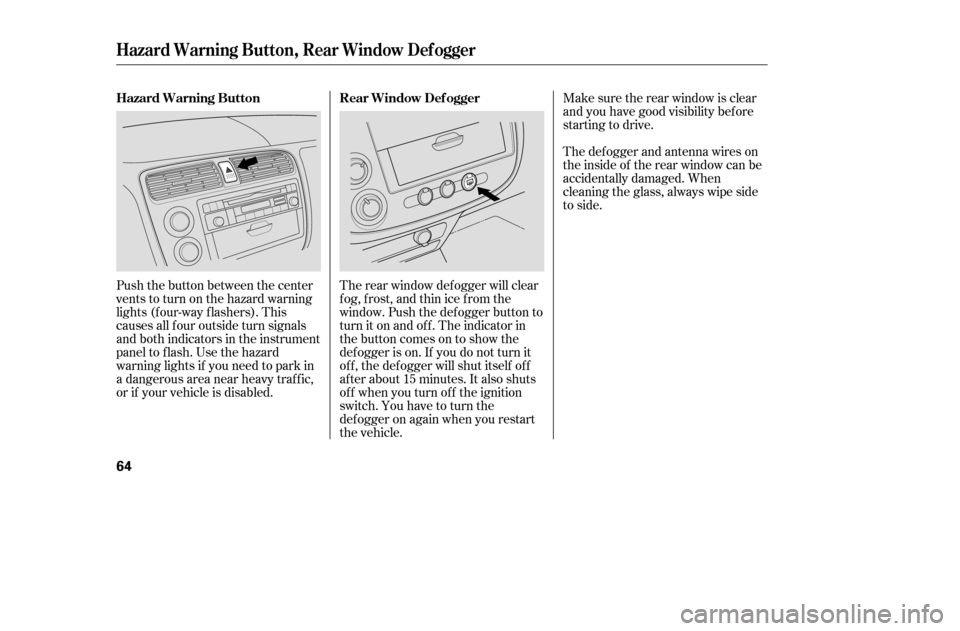Page 2 of 226
Your Vehicle at a Glance
4
HEADLIGHTS/TURN SIGNALS
MIRROR CONTROLS CRUISE CONTROL BUTTONSREAR WINDOW
DEFOGGER
WINDSHIELD WIPERS/WASHERS
AUDIO SYSTEM
STEERING WHEEL ADJUSTMENT HAZARD WARNING BUTTON
MOONROOF SWITCH
(P. 79)
CRUISE CONTROL
MASTER BUTTON
(P. 117)
(P. 80) (P. 62)
(P. 61) (P. 64)
(P. 92)CLOCK
(P. 115)
(P. 64)
ACCESSORY POWER SOCKET
(P. 85)
(P. 117)
(P. 65)
�����—�����—�����y�
�������������y���
�(���%�������y���������y
Page 3 of 226

�µ
You’ll f ind many saf ety
recommendations throughout this
section, and throughout this manual.
Therecommendationsonthispage
are the ones we consider to be the
most important.
A seat belt is your best protection in
all types of collisions. Airbags are
designed to supplement seat belts,
not replace them. So even though
your vehicle is equipped with airbags,
make sure you and your passengers
always wear your seat belts, and
wear them properly (see page ).
Alcohol and driving don’t mix. Even
one drink can reduce your ability to
respond to changing conditions, and
your reaction time gets worse withevery additional drink. So don’t drink
and drive, and don’t let your f riends
drink and drive, either.
While airbags can save lives, they
can cause serious or fatal injuries to
occupants who sit too close to them,
or are not properly restrained.
Inf ants, young children, and short
adults are at the greatest risk. Be
sure to f ollow all instructions and
warnings in this manual.
Children age 12 and under should
ride properly restrained in a back
seat, not the front seat. Infants and
smallchildrenshouldberestrained
in a child seat. Larger children
should use a booster seat and a lap/
shoulder belt until they can use the
belt properly without a booster seat
(see pages ).
Excessive speed is a major f actor in
crash injuries and deaths. Generally,
the higher the speed, the greater the
risk, but serious injuries can also
occur at lower speeds. Never drive
f aster than is saf e f or current
conditions, regardless of the
maximum speed posted.
Having a tire blowout or a
mechanical f ailure can be extremely
hazardous. To reduce the possibility
of such problems, check your tire
pressures and condition f requently,
and perform all regularly scheduled
maintenance (see page ).
14
44
27
152
Important Saf ety Precautions
Always Wear Your Seat Belt
Don’t Drink and Drive
Be Aware of Airbag Hazards
Restrain All Children
Control Your Speed
K eep Your Vehicle in Saf e
Condition
6
�����—�����—�����y�
�������������y���
�(���%�������y���������y
Page 26 of 226
�µ
To remind you of the passenger’s
f ront airbag hazards, and that
children must be properly restrained
in a back seat, your vehicle has
warninglabelsonthedashboard
(U.S. models) and on the f ront visors.
Please read and follow the
instructions on these labels.U.S. ModelsCanadian Models
Protecting Children General Guidelines
Driver and Passenger Saf ety
29
SUN VISOR
SUN VISOR
DASHBOARD
�����—�����—�����y�
�������������y���
�(���%�������y���������y
Page 46 of 226
Control L ocations
50
MIRROR
CONTROLSHEATING/COOLING CONTROLS
HOOD RELEASE
HANDLE CRUISE CONTROL
BUTTONS
FUEL FILL DOOR RELEASE
A/T model is shown. POWER WINDOW
SWITCHES
AUDIO SYSTEM
MOONROOF SWITCH
(P. 79)
POWER DOOR LOCK
MASTER SWITCH
(P. 69)
CRUISE CONTROL
MASTER BUTTON
(P. 117)
(P. 78)
(P. 124)(P. 117) ACCESSORY POWER
SOCKET
(P. 85)CLOCK
(P. 115)
(P. 92)
HAZARD WARNING BUTTON
(P. 88)
(P. 80)
(P. 64)
(P. 123)
TRUNK RELEASE
(P. 70)
�����—�����—�����y�
�������������y���
�(���%�������y���������y
Page 52 of 226

This indicator comes on if the trunk
lid is not closed tightly.
This indicator comes on as a
reminder that you must ref uel soon.
This indicator comes on when you
set the cruise control. See page
f or inf ormation on operating the
cruise control.
This indicator also blinks several
times when you turn the ignition
switch f rom ON (II) to ACCESSORY
(I) or LOCK (0). This indicator comes on when the
washer f luid level is low. Add washer
fluidwhenyouseethisindicator
(see page ).
The lef t or right turn signal indicator
blinks when you signal a lane change
or turn. If the indicator does not
blink or blinks rapidly, it usually
means one of the turn signal bulbs is
burned out (see page ). Replace
the bulb as soon as possible, since
other drivers cannot see that you are
signaling.
When you press the hazard warning
button, both turn signal indicators
blink. All turn signals on the outside
of the vehicle should f lash.
This indicator comes on f or a f ew
seconds when you turn the ignition
switch to ON (II). It will then go of f
if you have inserted a properly-coded
ignition key. If it is not a properly-
coded key, the indicator will blink,
and the engine will not start (see
page ).
172
117
67 164
Canadian models only
If equipped
Trunk-open Indicator
Low Fuel Indicator
Washer Level Indicator
Cruise Control Indicator
Immobilizer System
Indicator
Turn Signal and Hazard Warning
Indicators
Instrument Panel Indicators
56
�����—�����—�����y�
������
������y���
�(���%�������y���������y
Page 56 of 226
�Î
�Î
To use the horn, press the center pad of the steering wheel.
Controls Near the Steering Wheel
60
MIRROR CONTROLSREAR WINDOW
DEFOGGER
WINDSHIELD
WIPERS/WASHERS
MOONROOF
SWITCH
(P. 117) (P. 80) STEERING WHEEL ADJUSTMENT
(P. 65) (P. 64)
(P. 64)
(P. 61)
(P. 79)
HORNHAZARD WARNING BUTTON
INSTRUMENT
PANEL
BRIGHTNESS
(P. 63)
HEADLIGHTS/ TURN
SIGNALS
(P. 62)
CRUISE CONTROL BUTTONS
(P. 117)
CRUISE CONTROL
MASTER BUTTON
�����—�����—�����y�
������
����
�y���
�(���%�������y���������y
Page 60 of 226

Make sure the rear window is clear
and you have good visibility bef ore
starting to drive.
The def ogger and antenna wires on
the inside of the rear window can be
accidentally damaged. When
cleaning the glass, always wipe side
to side.
Push the button between the center
vents to turn on the hazard warning
lights (f our-way f lashers). This
causes all f our outside turn signals
and both indicators in the instrument
panel to f lash. Use the hazard
warning lights if you need to park in
a dangerous area near heavy traffic,
or if your vehicle is disabled. The rear window def ogger will clear
fog, frost, and thin ice from the
window. Push the def ogger button to
turn it on and off. The indicator in
the button comes on to show the
def ogger is on. If you do not turn it
of f , the def ogger will shut itself of f
af ter about 15 minutes. It also shuts
of f when you turn of f the ignition
switch. You have to turn the
def ogger on again when you restart
the vehicle.
Rear Window Def ogger
Hazard Warning Button
Hazard Warning Button, Rear Window Def ogger
64
�����—�����—�����y�
���������
���y���
�(���%�������y���������y
Page 69 of 226
�µ
To change the seat-back angle, pull
up on the lever on the outside of the
seat bottom.
Make all seat adjustments bef ore
you start driving.
To adjust the seat forward and
backward, pull up on the bar under
the seat cushion’s f ront edge. Try to
movetheseattomakesureitis
locked in position.
See pages f or important saf etyinf ormation and warnings about how toproperly position the seats and seat-
backs. 11 13
FrontSeatAdjustments
Seats
Inst rument s and Cont rols
73
�����—�����—�����y�
�������������y���
�(���%�������y���������y